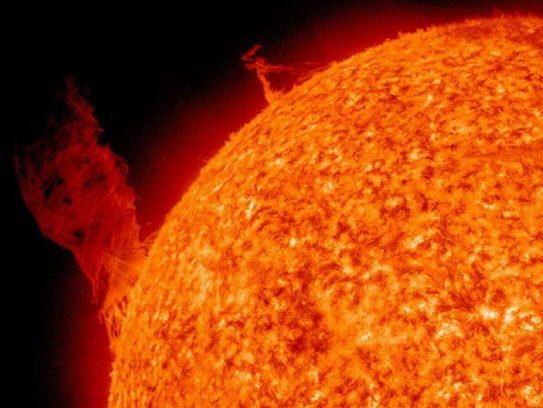|

A plasma vortex spins cross the Sun.
Credit: Solar Dynamics
Observatory/NASA
Solar Lightning
Aug
29, 2011
Solar flares can be thought of
as giant lightning discharges.
Conventional thinking suggests
that the Sun accelerates charged
particles into space in the same way
that sound waves are amplified.
Eruptions in the photosphere travel
outward through "acoustical
wave-guides," known as
magnetic flux tubes.
Structures called
spicules rise thousands
of kilometers above the photosphere
and carry the hot gas with them.
The Sun is the locus of positive
charge with respect to interstellar
plasma. Sunspots appear when
electric discharges penetrate the
photosphere, allowing electric
current to flow into its depths.
Electromagnetic flux tubes expose
the Sun's cooler interior. The idea
of acoustic heat transfer from the
core cannot be supported by any
observations of the Sun.
As standard theories about the
Sun propose, there is also a vast
"conveyor belt" circulating solar
matter down into magnetically active
zones deep inside the solar
interior, where it is "reenergized."
When sunspot magnetic fields begin
to decline, the conveyor belt pulls
what's left inside the Sun. As a
recent
press release states,
they are drawn 300,000 kilometers
below the surface, where they are
re-magnetized by the "solar dynamo."
The sunspots become buoyant in the
plasma flow, rising back up to the
photosphere to start a new solar
cycle.
In an Electric Universe, plasma
discharge behavior is a better model
for solar activity. Laboratory
experiments with a
positively charged sphere
show that a plasma torus forms above
its equator. Electric discharges
bridge the torus with the middle and
lower latitudes of the sphere.
Spicules are consistent with the
principle of "anode tufting," a
plasma discharge effect expected of
a positively charged
electric Sun.
Closeup images of sunspot
filaments, seen clearly in sunspot
penumbrae, indicate that they are
whirling charge vortices. Looking
down into a sunspot means seeing the
rotating discharge columns in
profile. Electric discharges in
plasma form rope-like, hollow
tendrils. Since they are funnels of
plasma, their centers are darker,
where convection cells would appear
darker at their edges.
Standard theory does not accept
that the darker and cooler regions
revealed by sunspots means that the
Sun is cooler in its interior.
"It is not coincidence that the
photosphere has the appearance, the
temperature and spectrum of an
electric arc; it has arc
characteristics because it is an
electric arc, or a large number of
arcs in parallel. These arcs quickly
result in the neutralization of the
accumulated space charge in their
neighbourhood and go out. They are
not therefore stable discharges, but
may rather be looked upon as
transient sparks. Arcs thus
continually appear and disappear. It
is this coming and going which
accounts for the observed
granulation of the solar surface." (A
New Approach in Astrophysics and
Cosmogony by
C. E. R. Bruce 1944)
Coronal arches and multiple loop
structures connect sunspots and rise
up to penetrate the chromosphere.
The chromosphere is a plasma sheath,
or
double layer region of
the Sun, where most of its
electrical energy is contained. When
the current flowing into the Sun's
plasma sheath increases beyond a
critical threshold it can trigger a
sudden release of that energy,
causing solar flares and enormous
prominence eruptions.
Powerful looping electric
currents generate secondary toroidal
magnetic fields that
surround the loop. When
the current grows too strong, the
plasma double layer is destroyed.
That event interrupts the current
flow and the stored electromagnetic
energy is blasted into space as a
solar flare. Solar flares can
therefore be thought of as
tremendous lightning bursts,
discharging vast quantities of
matter at near relativistic speeds.
Stephen Smith
 New
DVD New
DVD
The Lightning-Scarred
Planet Mars
A video documentary that could
change everything you thought you
knew about ancient times and
symbols. In this second episode of
Symbols of an Alien Sky, David
Talbott takes the viewer on an
odyssey across the surface of Mars.
Exploring feature after feature of
the planet, he finds that only
electric arcs could produce the
observed patterns. The high
resolution images reveal massive
channels and gouges, great mounds,
and crater chains, none finding an
explanation in traditional geology,
but all matching the scars from
electric discharge experiments in
the laboratory. (Approximately 85
minutes)
Video Selections
Order Link
|





 New
DVD
New
DVD

